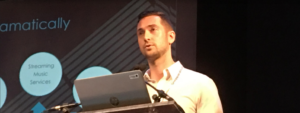Exclusives

M&E Industry Execs: Challenges Continue But VR, Other New Tech Present Opportunities
Story Highlights
NEW YORK — The music and game industries continue to face challenges in 2017, but there’s reasons for optimism, including the growing popularity of pay music subscriptions, relatively nascent technologies like augmented reality (AR), virtual reality (VR), machine learning and artificial intelligence (AI), and eSports, according to industry executives and analysts who spoke Sept. 26 at the New York Media Festival.
There’s been an “explosion” of new music streaming services that has “been very good for us all” in the media and entertainment (M&E) industry, Kyle Smetanka, senior product manager at TiVo, said during the Digital Music Forum that, along with the NY Games Conference, made up the first day of the Festival.
But all those services and the “plethora” of digital distribution formats we have today have come with “a bit of baggage,” he said. For one thing, he said, it’s more difficult than ever for artists to get attribution for their work and adequately be compensated for their performances. There’s long been this “infrastructure issue” in which it’s been difficult to identify and compensate singers and songwriters, he noted, but added: “With this market fragmentation that we see right now [and] the growth of these services” and business models, it’s “amplified” the problem.
He estimated that, as a result, more than $27 billion in revenue has been left “on the table” and not paid to music artists. Machine-based learning technology like TiVo’s, however, can be used to address the problem and may even revolutionize the music industry, he said.
 For example, he noted that the same song may be recorded by multiple artists and machine learning can be used to easily identify each of those many artists, resulting in the proper attribution and compensation in each case. “We think that this can fix this leaky pipe that we know today” throughout the industry, he said.
For example, he noted that the same song may be recorded by multiple artists and machine learning can be used to easily identify each of those many artists, resulting in the proper attribution and compensation in each case. “We think that this can fix this leaky pipe that we know today” throughout the industry, he said.
Streaming services have been helping the overall music industry and played a major role in its ability to generate double-digit revenue growth in the U.S. (of about 11%) in 2016 for the first time since 1998, Jem Aswad, senior editor at Variety, said earlier in the day during the Digital Music Forum.
Sony Music Entertainment (SME) is “cautiously optimistic” about the music sector based on what it’s seeing, Julie Greifer Swidler, its EVP of business affairs and general counsel, said. SME sees the emergence of multiple large and well-funded streaming music companies including Spotify, which she called the “market leader,” as a good thing for the music industry, she went on to say, predicting that Facebook will likely be among companies enter the streaming music category at some point.
Recent U.S. streaming music trends have been encouraging, analyst Russ Crupnick, managing partner at research company MusicWatch, told the Digital Music Forum. In the past year, streaming passed traditional AM/FM radio as the most popular way in which people are listening to music, he said, pointing to data that showed three of every four U.S. music listeners are now streaming.
The number of consumers paying for streaming services has also been growing, Crupnick said. The number of U.S. consumers who paid for an on-demand music subscription soared 150% last year, to 26 million, he said, predicting that will grow even more in 2017, to about 35 million people by the end of the year.
But many consumers remain on the fence when it comes to paying for a music subscription, he said, citing satisfaction listening to music via free AM/FM radio as the number one reason, according to the findings of a recent study.
That reason was followed by there being enough free music streaming options for some consumers and then satisfaction with existing music collections of CDs and downloads, he said.
 AM/FM music listening continues to be the dominant way that people access music while in their cars, Crupnick went on to say, citing data showing 45% of people did that – far ahead of streaming at 20%, satellite radio at 16%, built-in CD players at 13% and SD cards or hard drives at only 6%. The good news, however, was three of four people expressed interest in streaming while driving, he said.
AM/FM music listening continues to be the dominant way that people access music while in their cars, Crupnick went on to say, citing data showing 45% of people did that – far ahead of streaming at 20%, satellite radio at 16%, built-in CD players at 13% and SD cards or hard drives at only 6%. The good news, however, was three of four people expressed interest in streaming while driving, he said.
The growing popularity of AI-driven Personal Assistant Devices including Amazon Echo and Google Home, meanwhile, is already starting to create changing consumer behavior, Crupnick said. According to a recent poll, owners of such devices said that because they were using them, they were rediscovering older music, listening to their streaming services more, listening to their playlists more, discovering music from more new artists and listening to full albums more often, he said.
Games and promotional content around theatrical movie releases have hogged much of the spotlight so far when it comes to AR and VR. But music VR companies are among the few digital music startups getting significant funding now, attendees were told. They were represented at the Digital Music Forum by companies including Friends at Work and 8i.
In stark contrast, it’s hard to get funding for VR games now, Nanea Reeves, CEO and co-founder of VR startup TRIPP told the NY Games Conference. What’s helped has been the funding that the main VR hardware companies, including HTC Vive, have provided to content makers, she and John Linden, president of Seismic Games, said.
What’s also helping is that – just like in the console gaming space – it’s getting easier for VR content makers to create content as they gain experience using the platforms, Linden said.
A big challenge the VR market continues to face, however, is the “huge fragmentation factor,” Bjorn Book-Larsson, VP of product at HTC Vive, said, predicting that issue is “going to get worse before it gets better.”









